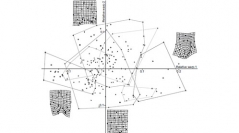

 Geodiversitas
33 (1) - Pages 177-197
Geodiversitas
33 (1) - Pages 177-197Several Cenozoic endocarp remains from the northern hemisphere have been described with strong affinities to either Menispermum L. or Sinomenium Diels, a monophyletic group of menispermous vines. It has been proposed that all of these fossil species are synonymous and should be included within Sinomenium. In order to evaluate this suggestion, we have studied the morphological variation ranges in the menispermous endocarps with geometric morphometrics, and then the ranges of the selected fossil endocarps is compared to the ranges of modern endocarps. The shape of each endocarp is described using eight landmarks and 17 semilandmarks, accounting for the outline and the positions of lateral ridge and foramen on the endocarps. Endocarp ornamentation is studied by statistical comparisons of the number of transverse ridges. It is concluded that the ranges of variation within the fossil genera, all morphologically related to horseshoe-shaped endocarps in Menispermaceae, are found not to be greater than that in the only extant species of Sinomenium, S. acutum (Th unb.) Rehder & Wilson. Sinomenium macrocarpum Liu & Jacques, 2010 differs from the other fossil species of Sinomenium by its higher number of transverse ridges. All other fossil species of Sinomenium, except S. macrocarpum, and Wardensheppeya Eyde, 1970 are synonymous. Menispermum? taylori Chandler, 1964 is transferred to Sinomenium. The fossil genus Palaeosinomenium Chandler, 1961 is confirmed through the obliquity of its endocarp, but all species are found to be synonymous. Menispermicarpum rariforme Chandler, 1961 is also included in Palaeosinomenium.
Menispermaceae, Menispermum, Sinomenium, morphometrics, semilandmark, fossil